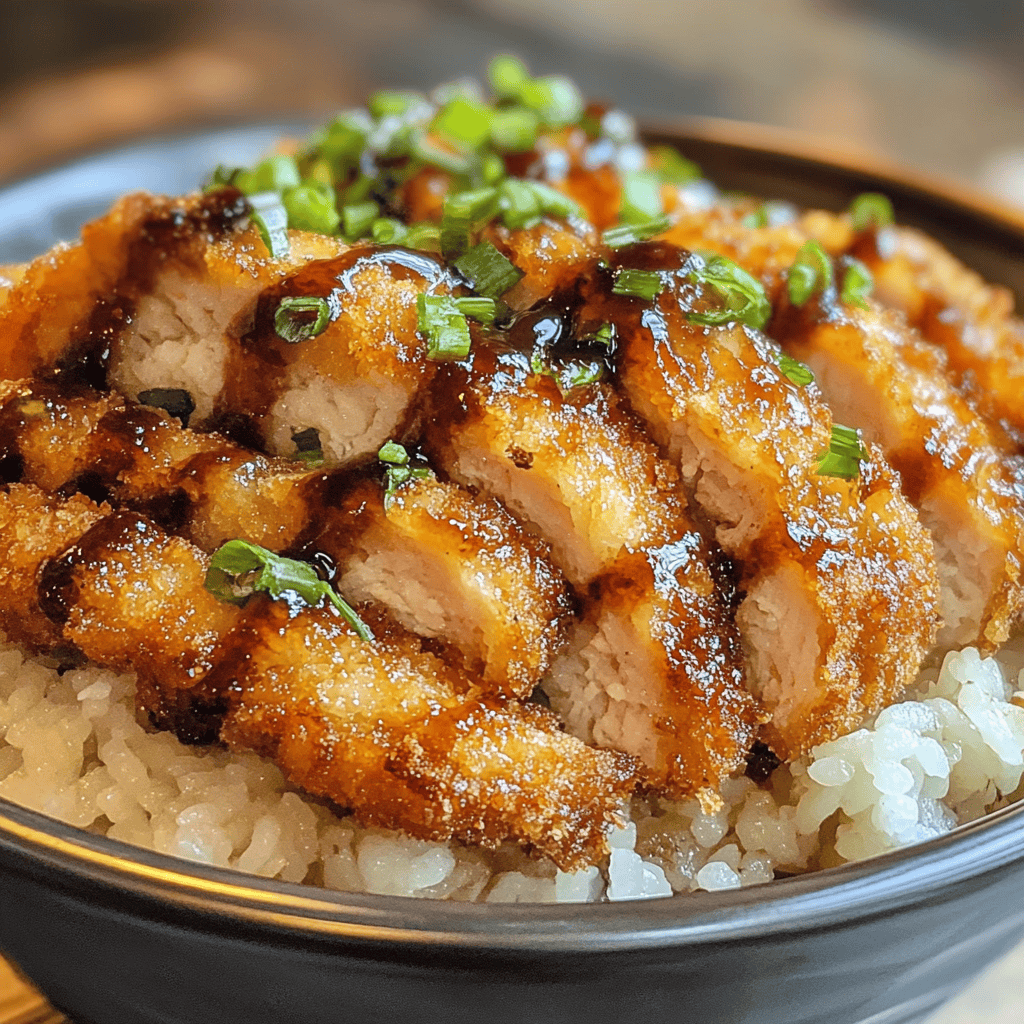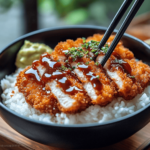Quick Overview
Japanese Katsu Bowls with Tonkatsu Sauce are a delightful and satisfying meal that brings the flavors of Japan right to your kitchen. This recipe features crispy breaded pork cutlets served over warm rice and topped with a rich, savory tonkatsu sauce. Perfect for a comforting dinner or a fun lunch, these bowls are easy to prepare and sure to impress your family and friends.
Ingredient Breakdown
Pork Loin Chops (4 pieces)
For this recipe, you will need four pork loin chops. These cuts are tender and juicy, making them perfect for frying. Ensure they are about one inch thick so they cook evenly while retaining their moisture.
Panko Breadcrumbs (1 cup)
Panko breadcrumbs give the katsu its signature crunch. They are coarser than regular breadcrumbs and absorb less oil during frying, resulting in a lighter texture. This ingredient is essential for achieving that crispy outer layer.
All-Purpose Flour (1/2 cup)
All-purpose flour is used to coat the pork before dipping it in egg and panko crumbs. This step helps the breadcrumbs adhere properly to the meat, ensuring an even coating that crisps up nicely when fried.
Eggs (2 large)
You will need two large eggs for this recipe. Beating the eggs creates a binding mixture that helps the panko breadcrumbs stick to the pork chops effectively. This contributes significantly to the overall texture of the dish.
Salt (1 teaspoon)
Salt enhances the flavors of all ingredients in this dish. Use one teaspoon to season both the pork chops and flour mixture for balanced taste throughout your katsu bowls.
Vegetable Oil (for frying)
Use enough vegetable oil to fill your frying pan about one inch deep. The oil should be hot enough for frying but not smoking. It allows the katsu to cook evenly while creating that golden-brown crust everyone loves.
Cooked White Rice (4 servings)
Serve your katsu on a bed of cooked white rice. The rice absorbs the flavors from the tonkatsu sauce and complements the savory pork perfectly. You can use jasmine or short-grain rice for best results.
Tonkatsu Sauce (1/2 cup)
Tonkatsu sauce is a tangy condiment made from fruits and vegetables blended with soy sauce and spices. Use half a cup of this sauce to drizzle over your finished katsu bowls, adding depth and flavor to each bite.
Step By Step Recipe: Japanese Katsu Bowls with Tonkatsu Sauce
Prepare the Pork Chops
Start by placing each pork chop between two sheets of plastic wrap or parchment paper. Use a meat mallet or rolling pin to gently pound them until they are about 1/2 inch thick. This technique tenderizes the meat and ensures even cooking throughout.
Season Flour Mixture
In a shallow dish, combine 1/2 cup of all-purpose flour with one teaspoon of salt. Mix well so that all parts of the flour are evenly seasoned. This step is crucial for maximizing flavor as it directly coats your pork chops before frying.
Set Up Breading Station
Next, set up your breading station by placing three shallow dishes side by side. Place seasoned flour in one dish, beaten eggs in another, and panko breadcrumbs in the last one. This organized setup will streamline the breading process as you work through each chop systematically.
Coat Pork Chops
Take each seasoned pork chop and first dip it into the flour mixture; shake off any excess flour before moving it into the beaten egg wash next. Finally, coat each chop thoroughly in panko breadcrumbs, pressing gently so they adhere well without falling off during frying.
Heat Oil for Frying
In a large skillet over medium heat, pour enough vegetable oil to fill it about an inch deep. Allow it to heat until shimmering but not smoking—this usually takes around 5-7 minutes depending on your stove settings; you can test readiness by dropping in small bits of bread which should sizzle immediately upon contact.
Fry Pork Chops
Carefully place each coated pork chop into hot oil without overcrowding the pan; fry them in batches if necessary. Cook on one side until golden brown and crisp—about 4-5 minutes—then carefully flip using tongs or spatula to fry on the other side until fully cooked through (internal temperature should reach 145°F).
Drain Excess Oil
Once cooked thoroughly on both sides, remove each katsu from oil using tongs or slotted spoon; place them onto paper towels lined on a plate or wire rack to drain excess oil effectively while keeping their crispiness intact—this step is important!
Slice Pork Chops
After allowing them some time to cool slightly, take sharp knife and slice each fried katsu into strips about half an inch wide; this will make serving easier while also allowing more surface area for soaking up delicious tonkatsu sauce when prepared later on!
Serve Over Rice
Take freshly cooked white rice and scoop equal portions into four serving bowls; arrange sliced katsu neatly on top of rice mounds ensuring good distribution across servings—this presentation enhances visual appeal while providing balanced portions too!
Drizzle with Tonkatsu Sauce
Finally drizzle generous amounts of tonkatsu sauce over sliced katsu pieces ensuring every bite gets flavorful touch! Optionally garnish bowls with chopped green onions or sesame seeds for added crunchiness if desired—serve immediately while still warm!
Serving and Storing Tips
Serving Suggestions
These Japanese Katsu Bowls are best enjoyed fresh but can be garnished further with toppings like pickled ginger or shredded cabbage alongside extra tonkatsu sauce at table ready! Pairing them with miso soup complements flavors nicely making complete meal experience enjoyable!
Storing Leftovers
To store leftovers properly allow any remaining katsu bowls cool completely before transferring them into airtight containers; refrigerate these sealed containers where they will stay fresh up until 3 days later! Reheat gently using microwave oven ensuring not overcook which keeps textures intact!
Enjoy crafting delicious Japanese Katsu Bowls with Tonkatsu Sauce at home!
Mistakes to avoid
One common mistake when making Japanese Katsu Bowls with Tonkatsu Sauce is not using the right cut of meat. Choose pork loin or tenderloin for a tender and juicy result. Avoid tougher cuts, as they can lead to a dry and chewy texture.
Another mistake is skimping on the breading process. Properly coat the meat in flour, egg, and panko breadcrumbs for that signature crunch. Neglecting any step will compromise the final texture.
Also, it’s essential to serve the sauce on the side rather than drenching the entire bowl. This allows diners to control the flavor intensity while maintaining the crispiness of the katsu.
Failing to let the fried pork rest before slicing is a significant error. Allowing it to rest helps retain its juices, ensuring every bite remains moist and flavorful.
Finally, don’t rush through cooking the rice. Perfectly cooked rice provides a wonderful base for your katsu bowl. Use short-grain sushi rice and follow cooking instructions carefully for optimal results.
Tips and tricks
To achieve perfect Japanese Katsu Bowls with Tonkatsu Sauce, start by prepping all your ingredients before you cook. Gather your pork, seasonings, breadcrumbs, and sauce beforehand. This will streamline your cooking process and ensure you don’t miss any crucial steps while preparing your dish.
When frying the katsu, maintain consistent oil temperature at around 350°F (175°C). Too low will result in greasy katsu while too high might burn it quickly. Use a thermometer to check your oil temperature before adding the breaded cutlet.
Consider marinating your pork in soy sauce and ginger for about 30 minutes before coating it. This adds depth of flavor to the meat and enhances its juiciness once cooked.
For an extra crispy texture, double-coat your pork using panko breadcrumbs. First dip in flour and egg mixture, then add another layer of panko before frying. This technique ensures a delightful crunch that holds up well against sauces.
Lastly, presentation matters! Serve your Japanese Katsu Bowls with Tonkatsu Sauce in an appealing manner by arranging sliced katsu over a bed of rice with colorful garnishes like green onions or pickled vegetables. A visually pleasing dish enhances the overall dining experience.
Suggestions for Japanese Katsu Bowls with Tonkatsu Sauce
For a twist on traditional Japanese Katsu Bowls with Tonkatsu Sauce, consider adding seasonal vegetables like tempura zucchini or sweet potatoes alongside your rice. These veggies add color and additional textures that make every bite delicious.
You can also experiment with different proteins like chicken or tofu for those who prefer alternatives to pork. These options can still deliver great taste when properly seasoned and cooked using similar methods as traditional katsu.
Pair your katsu bowl with a refreshing side salad dressed in sesame vinaigrette for balance. The crunchy greens will complement the richness of tonkatsu sauce beautifully while providing added nutrition to your meal.
Lastly, consider making homemade tonkatsu sauce if you want an authentic touch. Mixing Worcestershire sauce with ketchup, sugar, and soy sauce creates a flavorful blend that elevates your katsu bowl experience beyond store-bought options.
FAQs
What is tonkatsu sauce made of?
Tonkatsu sauce is typically made from a blend of ingredients including Worcestershire sauce, ketchup, soy sauce, sugar, and various spices. The combination creates a rich and tangy flavor profile that perfectly complements fried dishes like katsu.
Can I make Japanese Katsu Bowls with Tonkatsu Sauce ahead of time?
Yes, you can prepare many components of Japanese Katsu Bowls ahead of time! Cooked rice can be stored in an airtight container in the fridge while breaded pork cutlets can be prepared earlier in the day and fried just before serving for maximum freshness.
What sides pair well with Japanese Katsu Bowls?
Several sides pair wonderfully with Japanese Katsu Bowls with Tonkatsu Sauce. Consider serving pickled vegetables like sunomono or miso soup alongside the dish for added flavor complexity and balance to your meal’s richness.
How do I store leftover katsu?
To store leftover katsu effectively, place it in an airtight container after cooling down completely at room temperature. Refrigerate it for up to three days or freeze it for longer storage but remember that freezing may affect its crispiness upon reheating.
Is there a vegetarian option for katsu bowls?
Absolutely! For vegetarian versions of Japanese Katsu Bowls with Tonkatsu Sauce, use firm tofu or eggplant as substitutes for meat. Coat them similarly in flour and panko breadcrumbs before frying until golden brown; this gives them satisfying texture without sacrificing flavor!
Can I adjust spice levels in tonkatsu sauce?
Certainly! If you prefer spicier flavors in your tonkatsu sauce recipe, simply add chili paste or sriracha according to taste preferences during preparation. Adjustments allow you to create a personalized condiment that suits your palate perfectly!
Summary
In conclusion, mastering Japanese Katsu Bowls with Tonkatsu Sauce requires attention to detail throughout preparation processes such as selecting quality ingredients and avoiding common mistakes along the way. Incorporating tips on cooking techniques enriches both flavor profiles and presentations while enhancing overall enjoyment during meals shared among friends or family members alike!
Japanese Katsu Bowls with Tonkatsu Sauce
Description
Japanese Katsu Bowls with Tonkatsu Sauce are a delightful and satisfying meal that brings the flavors of Japan right to your kitchen. This recipe features crispy breaded pork cutlets served over warm rice and topped with a rich, savory tonkatsu sauce. Perfect for a comforting dinner or a fun lunch, these bowls are easy to prepare and sure to impress your family and friends.
Ingredients
Pork Loin Chops (4 pieces)
For this recipe, you will need four pork loin chops. These cuts are tender and juicy, making them perfect for frying. Ensure they are about one inch thick so they cook evenly while retaining their moisture.
Panko Breadcrumbs (1 cup)
Panko breadcrumbs give the katsu its signature crunch. They are coarser than regular breadcrumbs and absorb less oil during frying, resulting in a lighter texture. This ingredient is essential for achieving that crispy outer layer.
All-Purpose Flour (1/2 cup)
All-purpose flour is used to coat the pork before dipping it in egg and panko crumbs. This step helps the breadcrumbs adhere properly to the meat, ensuring an even coating that crisps up nicely when fried.
Eggs (2 large)
You will need two large eggs for this recipe. Beating the eggs creates a binding mixture that helps the panko breadcrumbs stick to the pork chops effectively. This contributes significantly to the overall texture of the dish.
Salt (1 teaspoon)
Salt enhances the flavors of all ingredients in this dish. Use one teaspoon to season both the pork chops and flour mixture for balanced taste throughout your katsu bowls.
Vegetable Oil (for frying)
Use enough vegetable oil to fill your frying pan about one inch deep. The oil should be hot enough for frying but not smoking. It allows the katsu to cook evenly while creating that golden-brown crust everyone loves.
Cooked White Rice (4 servings)
Serve your katsu on a bed of cooked white rice. The rice absorbs the flavors from the tonkatsu sauce and complements the savory pork perfectly. You can use jasmine or short-grain rice for best results.
Tonkatsu Sauce (1/2 cup)
Tonkatsu sauce is a tangy condiment made from fruits and vegetables blended with soy sauce and spices. Use half a cup of this sauce to drizzle over your finished katsu bowls, adding depth and flavor to each bite.





